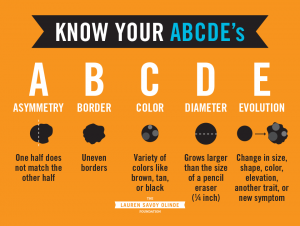Skin Cancer
Skin cancer is the most common cancer in the United States. The two most common skin cancers (basal cell and squamous cell carcinomas) are highly curable but can be disfiguring and costly. Melanoma (the third most common skin cancer) can be deadly. UV radiation from the sun or from a tanning device can cause dangerous, lasting damage to your skin.
General Risk Factors for Skin Cancer:
- Light skin or skin that burns, freckles or reddens easily (but skins of all colors can get skin cancer)
- Large number of moles
- Personal or family history of skin cancer
- History of sun exposure/sunburns
- Indoor tanning. The average tanning bed gives off 2 to 10 times more radiation than the sun and using tanning beds before the age of 35 increases a person’s risk for developing melanoma by 75%.
Skin Cancer in People of Color
Even if you have a darker skin type, always tan or rarely burn, you can still get skin cancer. Skin cancer is often diagnosed later in people of color, thus making it harder to treat. Melanoma in people of color most often occurs on the palms of the hands, soles of the feet, under the nail and in the nail areas. No matter your skin type, UV radiation can lead to skin damage, premature aging, and hyperpigmentation. Protecting your skin is important!
Preventing UV Light Exposure
Exposure to UV light causes most skin cancers and can be prevented with sun safety practices.
- Shade
- Find shade under a dense tree canopy.
- Carry a sun umbrella for personal shade.
- Use a pop-up UV shelter when at the beach/park.
- Stay out of the sun from 10am-4pm wherever possible as this is when UV radiation is the strongest.
- Sunscreen
- Use broad spectrum UVA and UVB, SPF30+.
- Reapplication is necessary every 2 hours and after swimming, sweating or toweling off.
- Use enough sunscreen. Aim for one ounce spread over all visible skin.
- Protective clothing
- Wear long sleeves/pants with built-in UPF.
- Use a wide-brimmed hat.
- Wear closed-toe shoes and socks that cover the ankle.
- Sunglasses
- Choose sunglasses with a UV protective coating.
- Wear sunglasses to protect the delicate skin around our eyes and reduce risk of cataracts & macular degeneration.
- UV Index
- Consider checking the UV index, which can often be found on your preferred weather app or on the EPA’s website.
ABCDEs of Melanoma
Know your skin and check it regularly. Keep an eye out for the following warning signs and make sure to show your medical provider.

Further Resources
Interested in learning more? Check out the following resources:
- National Council on Skin Cancer Prevention
- Skin Smart Campus
- Skin Cancer Foundation (skin cancer facts & statistics)
- How to Prevent Skin Cancer (American Academy of Dermatology)
- Dangers of Indoor Tanning (American Academy of Dermatology)
- Melanoma Educator Course for Healthcare Students (Melanoma Research Foundation)
- Your Skin is In (Impact Melanoma)
- Exposed Video (Impact Melanoma)
Skin Smart Campus

The University of North Carolina at Chapel Hill has been recognized as a Skin Smart Campus by The National Council on Skin Cancer Prevention by:
- Providing safe and healthy learning and living environments on- and off-campus
- Pledging to keep indoor tanning devices off our campus and out of our affiliated buildings.
- Promoting skin cancer prevention policies and education.
The Indoor Tan-Free Skin Smart Campus Initiative is sponsored by the National Council on Skin Cancer Prevention in response to the 2014 U.S. Surgeon General’s Call to Action to Prevent Skin Cancer which concluded that there is a strong association between increased risk of skin cancer and indoor tanning use. Ultraviolet (UV) radiation exposure from indoor tanning is completely avoidable which allows for interventions to help reduce skin-cancer related illness and deaths. Numerous studies have found that skin cancer is the most common type of cancer in the United States, with melanoma as one of the most common cancers diagnosed among young adults. According to the International Agency for Research on Cancer Working Group, the use of indoor tanning facilities before the age of 35 increases the risk of developing melanoma by 75%.
